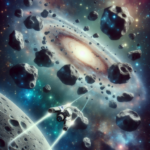Unveiling the Mystery: 26 Unknown Species Discovered in NASA’s Clean Room
The discovery of 26 unknown species in a NASA clean room has unraveled a tapestry of awe and wonder, showcasing the resilience and adaptability of life in the most unexpected places. The clean rooms at NASA, acclaimed for their stringent contamination controls meant to protect space missions from earthly bio-contaminants, have become the unexpected cradles of new microbiological discoveries. This finding not only challenges our understanding of life’s boundaries but also opens up new avenues for astrobiology.
In an environment where human presence is heavily controlled and external contamination is minimized, the persistence and emergence of these unknown species highlight the extraordinary survival strategies of microscopic life forms. The species, which likely evolved unique adaptations to thrive in such a sterile environment, underscore the vast, untapped biodiversity on Earth and possibly beyond. Their existence in a place designed to be inhospitable to life provokes intriguing questions about the adaptability and potential of life in extreme conditions, akin to those found in outer space.
The implications for astrobiology and planetary protection are profound. The discovery of these species in a NASA clean room could inform future protocols for interplanetary contamination control. Understanding how these organisms survive in extreme conditions—low nutrients, no sunlight, and harsh chemical cleansers—could provide critical insights into the resilience of life and inform the search for life on other planets. This unexpected finding underscores the complexity of life and the continuous need to refine our strategies for exploring the final frontier.
How Did Researchers Stumble Upon New Life Forms in NASA’s Sterile Environments?
In an astonishing revelation that sounds almost like a plot from a science-fiction novel, researchers have recently discovered new life forms residing within what are presumed to be the most sterile environments on Earth – NASA’s clean rooms. The discovery prompts a pivotal question: How did these organisms manage to survive, or even thrive, in conditions specifically designed to inhibit biological contamination? This finding not only challenges our understanding of life’s resilience but also sheds light on the potential for life in extraterrestrial environments.
The initial discovery was almost accidental, stemming from routine cleanliness checks and microbial monitoring in NASA facilities. These environments are meticulously controlled, with air filtration systems, chemical sterilants, and rigorous cleaning protocols, all aimed at creating a setting virtually inhospitable to any form of life, particularly to safeguard extraterrestrial missions from Earth-based contamination. Despite these extreme measures, scientists were startled to identify microorganisms that not only survived but adapted to these harsh conditions. This group of extremophiles – organisms that thrive in extreme environments – opened a new avenue of research into the limits of life on Earth and potentially beyond.
Further investigations into these tenacious life forms revealed that they possess unique adaptations and resilience mechanisms. These microorganisms have developed specialized systems to withstand chemical sterilization and extreme scarcity of nutrients, raising intriguing questions about the possibility of similar life forms existing in the cold, radiation-soaked vacuums of space. The presence of such organisms in NASA’s clean rooms underscores the ingenious ways life can persist and the potential need to redefine our standards of habitability.
The implications of this discovery extend beyond understanding life’s resilience; they pose significant considerations for planetary protection policies and the search for extraterrestrial life. If terrestrial organisms can adapt to the rigorous environments of NASA’s clean rooms, the possibility of contaminating space vessels and extraterrestrial sites with hardy Earth-based microorganisms becomes a genuine concern. It underscores the need for even more stringent sterilization techniques and the ongoing assessment of what constitutes a “sterile” environment, both for protecting other celestial bodies and for ensuring the integrity of future astrobiological discoveries.
The Impact of Discovering Unknown Species in Controlled Spaces on Future Space Missions
Discovering unknown species in controlled spaces, such as the International Space Station (ISS) or during planetary exploration missions, has profound implications for future space missions. The existence of these species, often microorganisms, highlights the resilience of life in extreme conditions, challenging our understanding of life’s limits. This discovery not only enriches biological science but also necessitates rigorous biosecurity measures to prevent terrestrial contamination and protect the integrity of extraterrestrial ecosystems.
Planetary Protection Policies must evolve in response to these findings. The potential discovery of extraterrestrial life forms requires an enhancement of existing protocols to prevent cross-contamination between Earth and other celestial bodies. The development of advanced decontamination technologies and containment methods will be paramount, ensuring that missions are conducted responsibly. Researchers and mission planners will need to balance scientific inquiry with the ethical considerations of interplanetary ecosystem preservation.
Furthermore, these discoveries have critical implications for astrobiology and the search for life beyond Earth. Identifying unknown species in controlled spaces provides vital clues about the types of life forms that might exist in other planetary environments. This knowledge influences the design and instrumentation of future exploratory missions, guiding scientists in developing more targeted life detection experiments. Understanding the survival strategies of these organisms can help in designing biospheres for long-duration space missions, ultimately aiding in humanity’s quest for sustainable space colonization.
Array










